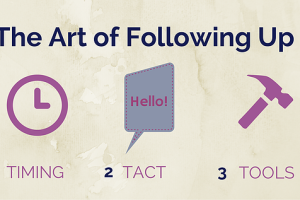Pricing conversations can be difficult. We all know that. But there’s nothing more frustrating than when an otherwise smooth-sailing sales presentation gets derailed by a customer’s objection to the price. It usually means one of two things: either they like what we have to offer, and they want to make a deal; or else they’re unconvinced that what we’re selling is worth the sticker price.
Both scenarios require a level head, common sense, and a sound negotiation strategy. In this post, we’ll take a look at three ways we can approach these conversations with poise and effectiveness.
Make sure you’re communicating real value.
Sometimes, when a customer says, “The price is too high,” what they really mean is that our value proposition is too low. There’s a mismatch between what they’re being asked to pay and what they expect our product or service to accomplish for them.
Such misalignment frequently derives from our failure to articulate how our solution addresses the customer’s most important “pain points” – or from emphasizing the wrong features. Let’s take a look at three common ways this might happen during our sales pitch:
- Failing to learn from the customer. We can’t sell a customer something they don’t believe they need. Perhaps that seems obvious, but the simple fact is that many of us rush into the sales presentation too quickly, giving a detailed exposition of our solution’s many features without first taking the time to inquire about what our prospect is looking for – the main problems they’re trying to solve, what sorts of things they’ve tried in the past, what obstacles they may face moving forward, etc. When we do this, we’re practically begging for a price objection because we don’t yet know what will create genuine value for them.
- Emphasizing non-valuable features. While it’s tempting for us to talk about all the features our solution might offer a prospect, it’s rarely wise to do this until we’re convinced that they’re already sold on the primary features that create value for them. Indeed, it’s likely that some of the features that create value for certain customers will have little or no impact on daily life for other customers. Some, in fact, could be seen as disruptive, because they may introduce new complications in the prospect’s way of doing business, entail additional training for personnel, replace existing system components that the prospect is already happy with, etc. In such cases, these “features” may sound more like hidden costs than additional value, and we’d do well to soft-pedal them for the time being. Why discuss the potential for cross-platform integration of our solution when our prospect hasn’t yet invested in cloud computing for their team? That may inadvertently communicate that they’ll be paying for features they won’t actually use. Better to focus, instead, on the way our solution allows a plethora of data mining options their current solution doesn’t, or on the way our solution integrates seamlessly with their existing data architecture, allowing them to make full use of historical data without having to start over.
- Talking too much, showing too little. Words are cheap when there isn’t concrete evidence that the solution we’re promising can actually deliver on its promise. Value often becomes tangible when our customers have an opportunity to engage with the product more directly. It’s always a good idea for us to come prepared with audiovisual aids that help our prospects contextualize some of the things we’re discussing in terms of an actual user experience – brochures with statistics, screenshots and case study examples, for instance, or (better still) a thumb drive loaded with an interactive product demo and video testimonials. And if there’s an opportunity to get the customer to engage a more hands-on technical demo, all the better!
Of course, these kinds of price objections are best dealt with proactively – by keeping them from coming up in the first place. If we’ve done a good job creating a sense of value for the customer, and if the customer is prepared to pay for that value, then price objections are more easily handled when they do arise. Instead of haggling over the bottom line, we can revisit those facets of our proposal that establish real value, reminding our prospect what they’re really paying for.
Try teasing out what the alternative might look like.
Sometimes, customers fail to appropriately value our proposal despite our best efforts. Usually, this is because they have an inaccurate or distorted perspective on how our solution relates to the alternatives available to them. When we sense this might be happening, we can tactfully try one of the following responses:
- “What other solutions are you considering right now?” Perhaps a competitor has already done a good job laying the groundwork for the customer, but their proposal is slightly lower than ours. It’s possible, and if so, we’d like to know – so we can try matching it. But what’s more likely is that the prospect hasn’t (yet) done a very thorough job surveying alternative solutions in the first place. We might, in fact, be the first (or only) solution they’ve considered so far. If that’s the case, we may know that our proposal is entirely competitive and reasonable, but the customer hasn’t yet figured that out for themselves, and they may need the space and freedom to explore those alternatives before they’ll be ready to move on our solution. It’s possible that they simply don’t realize what a solution like ours ought to cost, in other words, and we risk sounding condescending if we attempt to “educate” them right there on the spot. Our goal in this scenario is simply to be friendly, approachable, and available as they move forward. We might say something like, “It sounds like you might owe yourselves some more research in this area, and I’d love to help you out with that. But I think you’re going to find that our proposal is pretty competitive. Would you be interested in talking to some of our clients about how they reached their decision?”
- “Have you considered the cost of doing nothing?” This sort of question probes the level of interest the customer has in any solution, not just the one we’re offering. It may be that the customer isn’t sufficiently dissatisfied with the status quo of their current business environment to undertake the level of investment necessary to improve things. In these cases, a discounting strategy isn’t likely to be effective because it might reinforce the customer’s impression that we’re overpriced to begin with. A more fruitful strategy might be to help our prospectevaluate how much money they’re already wasting through inefficient processes that our solution might improve. Or, for customers facing eventual obsolescence of their current system, we might explore the opportunity costs of upgrading versus cross-grading – majoring on marginal value that could be generated through the latter. In these and similar situations, our role may shift temporarily from salesperson to consultant. The basic idea is that, well before we discount our offering, we help our prospect better assess its value in their current operating environment. Then, if we eventually do compromise on price, the impact of a small discount will be greater.
- “What kind of budget did you have in mind for something like this?” This is a straightforward, tasteful way to assess whether there’s a gross misalignment of the prospect’s financial situation and your own needs to do business with them. Even when a prospect is fully sold on the value of our proposal and feels that our price point is fair, they may attempt to win a discount from us to improve their sense of control in the negotiations. If that’s the case, perhaps we can negotiate an appropriate discount in exchange for something of value to us– such as permission to use their implementation story as a case study for future marketing efforts, or referrals to other business partners who might have similar needs to theirs. But if the price point they express is unreasonably low, this might be the time to cut our losses and respectfully decline to bid further. We could say something like, “I respect that. Unfortunately, I’m not sure that we’d be able to provide the value you’re needing for what you’re prepared to spend. If something changes for you as you begin exploring other options, please, let me know. In the meantime, could I leave you with some literature for reference as you explore?”
Drill down to the basics.
Let’s face it. Sometimes money is just a bigger deal for certain customers than it is for others. And especially in highly competitive markets, price may become the easiest metric of comparison for seemingly similar solutions. While we want to avoid getting drawn into a price war with competitors, it occasionally makes good business sense to discount our offering rather than lose a prospect we’ve already invested a lot of time and effort in. Here are a few questions that can help us feel out whether a discount is likely to effective, if offered:
- “Is price the most important consideration in making your decision?” This calls a prospect’s bluff. Most of the time, price won’t be the most important consideration, of course, and this gives us a chance to find out what isthe most important factor for them – so that we use our knowledge of competitive offerings to decide whether the prospect is likely to be satisfied by another product. If we feel our solution stands head and shoulders above the competition in some key respect that the prospect values highly, we have plenty of room for holding the course on a premium price. If not, it might be smart to consider whether the lowest-priced competitive offering is one we’re prepared to match.
- “Would a payment plan make a difference?” This sort of question aims to uncover whether this is really “sticker shock” or simply an issue of cash flow. Thousands of dollars up front may be less feasible for a customer than installments of several hundred dollars over time. If the mention of a payment plan changes the tone of the conversation, then we know that it isn’t a matter of discounting the offering, but of negotiating terms for payment – and at that point, offering an interest-free payment plan will add value to the proposal that a competitor might be unable to match.
- “Has something changed since we last talked?” Occasionally, pricing issues have been discussed previously, and no objections were raised – until it was time to get down to brass tacks. In a circumstance like this, the customer may simply be haggling for the sake of not wanting to pay full price. If so, that’s fine. But sometimes, a price objection raised this late in the game is actually a diversionary tactic – a way of masking a deeper-seated objection that hasn’t been adequately addressed earlier in the sales process. If that’s the case, this question gives us a chance to uncover it so that we can (hopefully) take it up separately. Perhaps someone higher up the flagpole has expressed reservations over our product, or perhaps a competitor has sweetened their proposal upon learning that our prospect was considering other options. Whatever it might be, we’d like to find out so that we can decide whether it’s worth our time (and promotional pricing strategy) to continue pursuing this opportunity.









Speak Your Mind